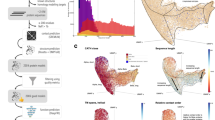Abstract
The archaeal, bacterial, andeukaryotic genome projects have overwhelmed our ability to experimentally elucidate the function of each novel gene and gene product. To a certain extent, protein functional assignments can be derived via sequence similarity measures and direct primary sequence analysis using methods to predict hydropathy, secondary structure, amphilicity, and antigenicity. Function can also be inferred on the basis of sequence motifs, such as phosphorylation and lipid binding signatures. These methods, provided in DNASTAR’s PROTEAN module, can be used to putatively assign roles for novel proteins from the genome explosion as well as clarify function for better known proteins.
Similar content being viewed by others
Explore related subjects
Discover the latest articles and news from researchers in related subjects, suggested using machine learning.References
Smith, T. F. and Zhang, X. (1997) The challenges of genome sequence annotation of “the devil is in the details.” Nat. Biotechnol. 15(12), 1222–1223.
Garavito, M. R. and White, S. H. (1997) Membrane proteins structure, assembly and function: A panoply of progress. Curr. Opin. Struct. Biol. 7, 533–536.
Pebay-Peyroula, E., Rummel, G., Rosenbusch, J. P., and Landau, E. M. (1997) X-ray structure of bateriorhodopsin at 2.5 angstroms form microcystals grown in lipidic cubic phases. Science 277, 1671–1681.
Moffat, A. S. (1997) Opening the door to more membrane protein structures. Science 277, 1607,1608.
Tjandra, N. and Bax, A. (1997) Direct measurement of distances and angles in biomolecules by NMR in a dilute liquid crystalline medium. Science 278, 1111–1114.
Jung, K., Jung, H., Wu, J., Priv, G. G., and Kaback, H. R. (1993) Use of site-directed fluorescence labeling to study proximity relationships in the lactose permease of Escherichia coli. Biochemistry 32, 12,273–12,278.
Maggi, C. A. and Schwartz, T. W. (1997) The dual nature of the tachykinin NK-1 receptor. Trends. Pharmacol. Sci. 18, 351–355.
Chou, P. Y. and Fasman, G.D. (1978) Prediction of the secondary structure of proteins from their amino acid sequence. Adv. Enzymol. 47, 45–148.
Garnier, J., Osguthorpe, D. J., and Robson, B. (1978) Analysis of the accuracy and implications of simple methods for predicting the secondary structure of globular proteins, J. Mol. Biol. 120, 97–120.
Kyte, J. and Doolittle, R. F. (1982) A simple method for displaying the hydropathic character of a protein. J. Mol. Biol. 157, 105–132.
Eisenberg, D., Weiss, R. M., and Terwilliger, T. C. (1984) The hydrophobic moment detects periodicity in protein hydrophobicity. Proc. Natl. Acad. Sci. USA 81, 140–144.
Karplus, P. A. and Schultz, G. E. (1985) Prediction of chain flexibility in proteins. Naturwissenschaften 72, 212,213.
Jameson, B. A. and Wolf, H. (1988) The antigenic index: A novel algorithm for predicting antigenic determinants. Comput. Appl. Biosci. 4, 181–186.
Emini, E. A., Hughes, J. V., Perlow, D. S., and Boger, J. (1985) Induction of hepatitis A virus-neutralizing antibody by a virus-specific synthetic peptide. J. Virol. 55, 836–839.
Author information
Authors and Affiliations
Corresponding author
Rights and permissions
About this article
Cite this article
Plasterer, T.N. Protean. Mol Biotechnol 16, 117–125 (2000). https://doi.org/10.1385/MB:16:2:117
Issue Date:
DOI: https://doi.org/10.1385/MB:16:2:117




